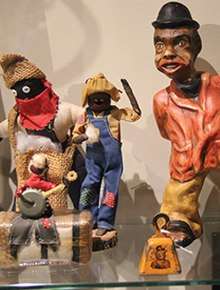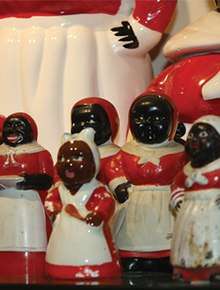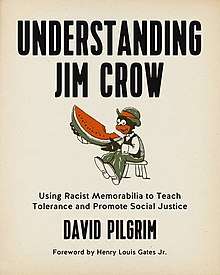Jim Crow Museum of Racist Memorabilia
|
| |
 Location within Michigan | |
| Established | 1996 |
|---|---|
| Location | Big Rapids, Michigan |
| Coordinates | 43°41′15″N 85°28′57″W / 43.68748°N 85.48243°WCoordinates: 43°41′15″N 85°28′57″W / 43.68748°N 85.48243°W |
| Type | History museum |
| Collection size | 10,000 |
| Curator | Dr. David Pilgrim |
| Owner | Ferris State University |
| Website |
www |

The Jim Crow Museum of Racist Memorabilia at Ferris State University, Big Rapids, Michigan, displays a wide variety of everyday artifacts depicting the history of racist portrayals of African Americans in American popular culture.[1] The mission of the Jim Crow Museum is to use objects of intolerance to teach tolerance and promote social justice.[2]
The Jim Crow Museum of Racist Memorabilia has a collection of over 10,000 objects, primarily created between the 1870s and the 1960s. It also includes contemporary objects.
The museum demonstrates how racist ideas and anti-black images were pervasive within American culture. It also shows how these images and ideas have resurfaced in recent years. Stories about African American achievements during the Jim Crow era, along with artifacts of the Civil Rights Movement, are also found within the museum.
History
Dr. David Pilgrim, (a former professor of sociology, and now Vice President for Diversity and Inclusion at Ferris State University), started to collect racist memorabilia in flea markets across America in the 1970s. By 1996, the collection had grown to over 2,000 pieces, and Dr. Pilgrim decided to donate the collection to Ferris State because "it needed a real home."[3] The collection was housed for 15 years in a small space, utilized as a teaching tool for university classes.[3] In 2012 the Jim Crow Museum was opened to the public as a larger, brand new facility, located in the lower level of Ferris State University's FLITE Building.
About the museum
The Jim Crow Museum houses over ten thousand artifacts; the majority of the objects were created between the 1870s and the 1960s. The largest portion of the museum's holdings is anti-black memorabilia, for example, mammy candles, Nellie fishing lures, picaninny ashtrays, sambo masks, and lawn jockeys. These objects both shaped and reflected attitudes toward African Americans during the Jim Crow era. The museum also displays Jim Crow memorabilia - books, signs, tickets, brochures, and photographs - that promoted racial segregation.
The museum demonstrates how racist ideas and anti-black images were pervasive within American culture. It also shows how these images and ideas have resurfaced in recent years. Stories about African American achievements during the Jim Crow era, along with artifacts of the Civil Rights Movement, are also found within the museum.
Museum's mission

Many of today's students have only a vague understanding of the impact of Jim Crow laws and customs. More specifically, they lack a fundamental knowledge of restrictive covenants, literacy tests, poll taxes, and other oppressive features of the Jim Crow racial hierarchy. The Jim Crow Museum is a powerful teaching tool, offering students an opportunity to learn about this important period in the history of the United States.
Most of the objects displayed in the museum were created with the intent of belittling and humiliating African Americans. Nevertheless, the museum's staff believes that these objects can be used to fuel intelligent discussions about race, race relations, and racism.
Woodbridge N. Ferris, the founder of Ferris Institute (now Ferris State University), challenged faculty, staff, and students to "make the world a better place". The Jim Crow Museum is one attempt by the university to improve the world. This is seen in the museum's mission to "use objects of intolerance to teach tolerance and promote social justice".
Visiting the Museum
The Jim Crow Museum is open and is free to the public. The Museum features six exhibit areas:[2]
- Who and What was Jim Crow
- Jim Crow Violence
- Jim Crow and Anti-Black Imagery
 Mammy figurines in the Jim Crow Museum.
Mammy figurines in the Jim Crow Museum.  Understanding Jim Crow, by Dr. David PilgrimAchieving Despite Resistance
Understanding Jim Crow, by Dr. David PilgrimAchieving Despite Resistance Watermelons, Nooses, and Straight Razors, by Dr. David Pilgrim
Watermelons, Nooses, and Straight Razors, by Dr. David Pilgrim- The Battle Continues (contemporary forms of racism)
- A New Wave of Egalitarianism (positive representations of African Americans)
The Museum also offers a comprehensive timeline of the African American experience in the United States. The timeline is divided into six sections: Africa Before Slavery, Slavery in America, Reconstruction, Jim Crow, Civil Rights and Post Civil Rights.
The Jim Crow Museum at Ferris State University strives to become a leader in social activism and in the discussion of race and race relations.
A virtual tour of the museum, recorded by Real Space of Grand Rapids, is also available here.
See also
References
- ↑ Fox, Helen (2009). When Race Breaks Out: Conversations about race and racism in college classrooms (Revised ed.). New York: Peter Lang Publishing. p. 202. ISBN 978-1-4331-0592-0.
- 1 2 "Jim Crow Museum - Ferris State University". ferris.edu. Retrieved 2018-01-30.
- 1 2 Householder, Mike (April 19, 2012). "Newest Michigan museum showcases racist artifacts". Yahoo! News. Associated Press. Retrieved June 6, 2012.